Hey there, fellow food lovers! If you’ve ever wondered, “What is chicken seasoning, anyways?” then you’ve stumbled into the right spot. At its core, chicken seasoning is a magical mix of herbs, spices, and sometimes a pinch of other goodies like salt or sugar, all blended together to turn boring ol’ chicken into a mouthwatering masterpiece. Whether you’re grilling, baking, or frying, this stuff is your ticket to flavor town. Stick with me, and I’ll spill all the deets on what it’s made of, how to use it, and why it’s gonna be your new kitchen BFF.
Chicken Seasoning 101: Breaking It Down
Let’s get straight to the good stuff. Chicken seasoning ain’t just one thing—it’s a whole vibe. It’s a combo of flavors designed to make chicken sing and it can be as simple or as wild as you want. The beauty of chicken is that it’s kinda like a blank canvas; it’s got a mild taste on its own, so it soaks up whatever you throw at it. That’s where seasoning steps in to save the day.
So, what’s in this mystical mix? Well, most blends start with some basic building blocks, then get jazzed up depending on your style or the cuisine you’re aiming for. Here’s the lowdown on the usual suspects:
- Salt: The MVP of flavor. It don’t just make things salty—it pulls out the natural juices in chicken, making the skin crispy when you roast or fry it. Plus, it amps up everything else in the mix.
- Pepper: Usually black pepper, but sometimes white or a fancy blend. It adds a lil’ kick, a subtle heat that plays nice with richer flavors.
- Garlic Powder: Oh man, this stuff is everywhere, and for good reason. It’s got that punchy, savory vibe that makes your chicken taste like it’s been loved on. Cooked, it mellows out to a sweet note.
- Paprika: This can be sweet, smoky, or hot, depending on what you grab. It gives a warm, gentle depth to your dish and sometimes a pop of color too.
- Onion Powder: A softer, sweeter cousin to garlic powder. It layers in that cozy, homey taste without being in your face.
- Oregano: A Mediterranean rockstar with a warm, slightly bitter edge. It’s like a hug for your chicken, especially in Italian or Greek dishes.
- Thyme: Earthy with a hint of lemon, this herb is a workhorse. It’s great in rubs, sauces, or just sprinkled over a roast.
These are the basics but the fun don’t stop there. Depending on who’s mixing or what part of the world you’re pulling inspo from you might find cumin for an earthy warmth, rosemary for a piney punch, or even a dash of brown sugar to caramelize the outside and add a sweet twist. I’ve even tossed in some weird stuff like dried lemon peel to zesty-fy my bird, and lemme tell ya, it’s a game-changer.
A World of Flavor: Regional Twists on Chicken Seasoning
One of the coolest things about chicken seasoning is how it changes depending on where you are or what kinda food you’re craving. It’s like a passport for your palate. Here’s a quick tour of some popular styles me and my kitchen have explored
- Cajun Kick: This blend is all about bold and spicy. Think cayenne pepper, paprika, garlic, and thyme. It’s got a fiery attitude that’s perfect for a blackened chicken straight outta Louisiana.
- Mediterranean Magic: Light, bright, and herbaceous, this mix often has oregano, basil, rosemary, and sometimes a hint of lemon zest. It’s like sunshine on a plate, amazing for grilled chicken skewers.
- BBQ Rub Bliss: Sweet, smoky, and a tad spicy, BBQ rubs usually got brown sugar, paprika, chili powder, and cumin. Slather this on before grilling, and you’ve got a crust that’ll make your neighbors jealous.
- Caribbean Jerk: This one’s got heat and sweetness in spades. Allspice, cinnamon, thyme, and scotch bonnet peppers (if you’re brave) bring the island vibes. I tried this on wings once, and my fam couldn’t stop raving.
These are just a few stops on the flavor train. You’ve also got Indian-inspired mixes with turmeric and ginger for curries, or Middle Eastern shawarma blends with cumin and coriander. The world’s your oyster—or, well, your chicken!
How to Use Chicken Seasoning Like a Pro
Alright, now that you know what’s in it, let’s talk about how to slap this stuff on your chicken and make it shine. There’s a few ways to go about it, and I’ve messed around with all of em to figure out what works best.
Dry Rubs: Rub It In, Baby
This is my go-to when I’ve got a bit of time. Mix your seasoning blend, pat your chicken dry with paper towels (wet chicken = no stick), and rub that mix all over. Get under the skin if you’re dealing with a whole bird or pieces with skin on—it flavors the meat directly. Here’s the kicker: let it sit for at least an hour in the fridge, or even up to 12 hours if you’re planning ahead. The longer it marinates, the deeper the flavor. I once forgot a batch overnight, and dang, that was some of the juiciest, tastiest chicken I ever made.
Marinades: Soak Up the Goodness
If you wanna get fancy, mix your seasoning with some oil and an acid like vinegar or lemon juice to make a marinade. This not only flavors the chicken but tenderizes it too. Soak your pieces in it for a few hours (don’t go past 24, or it might get mushy), then cook as usual. I’ve done this for grilled thighs, and they came out so tender I nearly cried.
Sprinkling: Quick and Dirty
Ain’t got time? Just sprinkle that seasoning on right before cooking, or even after if it’s already cooked. It’s not as deep a flavor punch, but it works in a pinch. I do this when I’m air-frying wings and forgot to prep ahead. Still tasty, just not as “whoa.”
A Quick Tip on Quantity
How much should you use? A good rule of thumb is about 1 tablespoon of seasoning per pound of chicken. If you’re working with smaller bits like wings, you might need a tad more since there’s more surface area. Play it by ear—taste and adjust as you go.
DIY Chicken Seasoning: Make Your Own Mix
Why buy when you can DIY, right? Making your own chicken seasoning is stupid easy and lets you control what’s in it. No weird additives, no extra salt if you’re watching that, just pure flavor. Here’s a basic recipe I’ve whipped up in my kitchen that’s never let me down. It’s enough for about 5 pounds of chicken, so scale it as needed.
| Ingredient | Amount | Why It’s There |
|---|---|---|
| Brown Sugar | 2 tablespoons | Adds sweetness and helps caramelize the outside |
| Paprika | 1 tablespoon | For warmth and color, use smoked if you like it smoky |
| Dried Oregano | 2 teaspoons | Gives a herby, Mediterranean vibe |
| Garlic Powder | 1 teaspoon | Savory punch that’s a must-have |
| Salt | 1 teaspoon | Enhances all the flavors, adjust to taste |
| Onion Powder | ½ teaspoon | Sweet, subtle oniony depth |
| Black Pepper | ½ teaspoon | A lil’ heat and complexity |
| Cayenne Pepper | ¼ teaspoon | Just a touch of spice, skip if you’re shy |
How to Make It: Toss all this in a small bowl, mix it up real good, and store in an airtight jar or zip bag in a cool, dry spot. Label it so you don’t mix it up with your taco blend (been there, done that). This mix should last about 6 months if your spices are fresh. Use it like I mentioned—rub it on, let it sit, and cook your heart out.
Wanna switch it up? Add a couple teaspoons of chili powder for a Tex-Mex twist, or swap oregano for thyme and rosemary if you’re feeling fancy. I’ve even thrown in a pinch of cumin when I’m making something with a Middle Eastern flair. Experiment, fam—it’s half the fun!
Storage Smarts: Keep It Fresh
Speaking of storage, let’s chat about keeping your seasoning blend from going stale. If you make a big batch like I do (cuz who’s got time to mix every dang day?), store it right. Stick it in an airtight container—think a small glass jar or a zip-top bag—and keep it in a cool, dry place away from heat. Don’t put it near the stove; heat kills the potency of herbs and spices faster than you can say “burnt chicken.” A cupboard or spice drawer works perfect. If stored right, a homemade mix can last 6 to 12 months, though the flavor might fade a bit over time. Sniff it—if it don’t smell strong no more, it’s time for a fresh batch.
Beyond Chicken: Versatility is Key
Here’s a lil’ secret: chicken seasoning ain’t just for chicken. I know, mind blown, right? You can use it on other meats like turkey, pork, or even fish, though you gotta think about how the flavors match up. A sweet BBQ rub might be weird on delicate fish, but a herby Mediterranean blend could work. I’ve dusted it on pork chops before grilling, and it was a hit.
Even cooler? Try it in vegetarian dishes. Sprinkle some on roasted veggies or tofu to give ‘em that savory depth. I’ve mixed it into soups and stews for an extra flavor kick too. One time, I tossed a pinch into a potato salad just to see what’d happen, and lemme tell ya, it was bussin’. Get creative—there’s no rules here.
My Personal Chicken Seasoning Fiasco (and Triumph!)
Alright, I gotta share a story from my kitchen disasters to make ya feel better about your own. First time I tried making my own seasoning, I went overboard with the cayenne. Thought I’d be a tough guy and add a whole tablespoon instead of a quarter teaspoon. Big mistake. My poor chicken wings had us all chugging water and wiping tears at the dinner table. My kid looked at me like I tried to poison ‘em! But hey, I learned—start small with the heat and build up. Now, I’ve got that mix down pat, and those same wings get requests every game night. Moral of the story? Mess up, laugh it off, and keep tweaking till it’s perfect.
Another win was when I mixed my basic blend with some butter and smeared it all over a whole chicken before roasting. Holy smokes, the skin came out crispy and golden, and the meat was so juicy we didn’t need no gravy. Try that trick if you wanna impress at Sunday dinner.
Tips and Tricks to Level Up Your Seasoning Game
Before I let ya go, here’s a few more nuggets of wisdom I’ve picked up along the way to make your chicken seasoning journey even smoother:
- Pat It Dry: Always dry your chicken with paper towels before seasoning. Wet meat don’t hold onto rubs well, and you’ll miss out on that crispy goodness.
- Oil It Up: A light rub of olive oil before seasoning helps the mix stick better. It’s a small step that makes a big diff.
- Don’t Reuse: If your seasoning touches raw chicken or your hands while handling it, toss what’s left of that batch. Don’t risk cross-contamination. Safety first, peeps!
- Grilling Hacks: If you’re grilling, add a touch of brown sugar or honey to your mix. It’ll create a killer crust. Just watch for burning—sugar chars quick.
- Low Salt Option: Watching sodium? Cut back on salt in your blend and bump up the herbs and spices. You won’t miss it, I promise.
- Marinate Smart: If you’re marinating, don’t leave it too long with acidic stuff like lemon juice. Over 24 hours can turn your chicken mushy. Learned that the hard way, y’all.
Wrapping It Up: Get Seasoning, Get Cooking!
So there ya have it, everything you ever wanted to know about what chicken seasoning is and how to make it work for you. It’s all about blending herbs, spices, and a lil’ love to turn plain chicken into something spectacular. Whether you stick to a basic mix of salt, pepper, and garlic or go wild with a Caribbean jerk or smoky BBQ rub, the power’s in your hands. I’m tellin’ ya, once you start playing with these flavors, you ain’t going back to bland bird.
Why not whip up a batch of your own seasoning mix this weekend? Grab those pantry staples, mix ‘em up, and slap it on some chicken thighs or breasts. See what vibes with your taste buds. And hey, drop a comment below if you’ve got a killer combo or a funny kitchen fail to share—I’m all ears! Let’s keep this flavor party goin’. Now, go get cookin’!
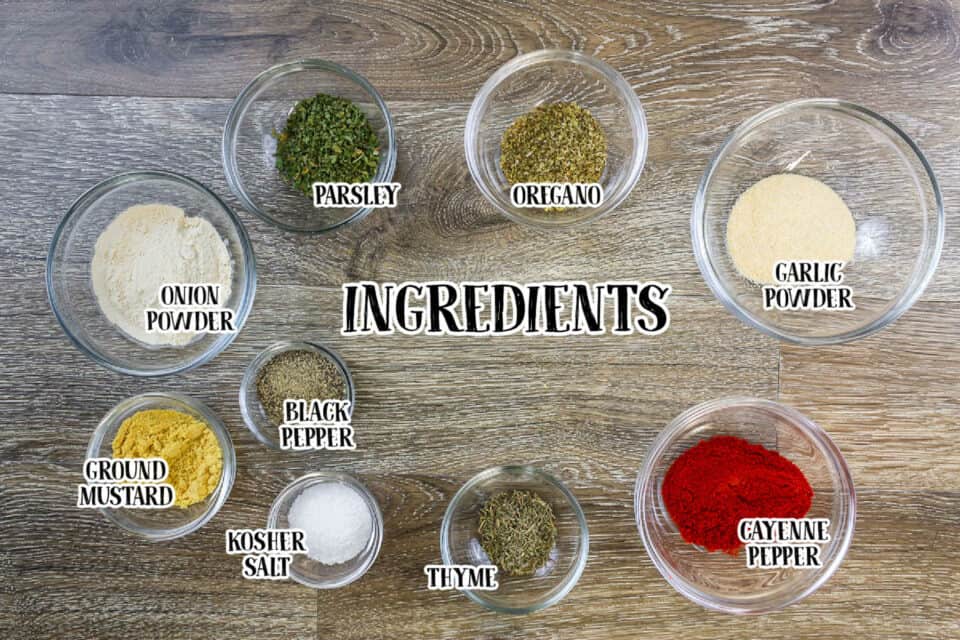
Best Way To Season Chicken
The best seasoning can be as easy as grabbing a specific spice rub like Italian seasoning or Greek seasoning, but if you have picky eaters you can go with an all purpose seasoning like this one.
The best part of chicken is that it goes with just about every flavor profile you can think of!
Made with spices and herbs from your pantry, this easy chicken seasoning creates juicy, tender meat bursting with flavor. If you are grilling, baking or roasting chicken, this is perfect for a whole chickens, breasts, wings or thighs.
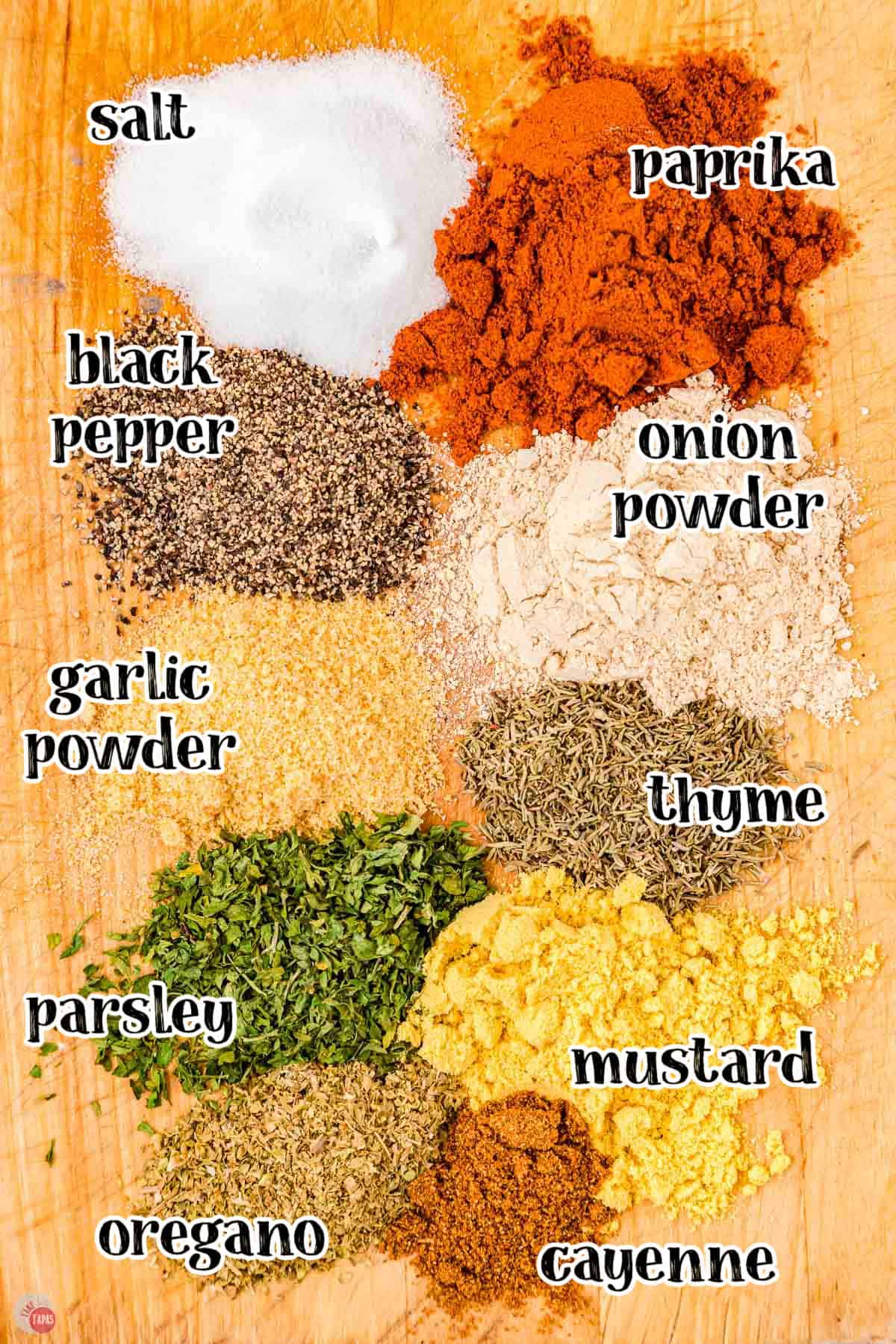
See recipe card for complete information on ingredients and their quantities.
- Use only the highest quality spices.
- Check the expiration dates and buy the freshest ones you can find.
- Give the herbs (oregano, thyme, and parsley) a rub between the fingers to release their oils and make them more potent.
For more insider tips, tricks, and a behind the scenes look, follow me on Pinterest, Facebook, Instagram, & X.
How To Make Chicken Seasoning
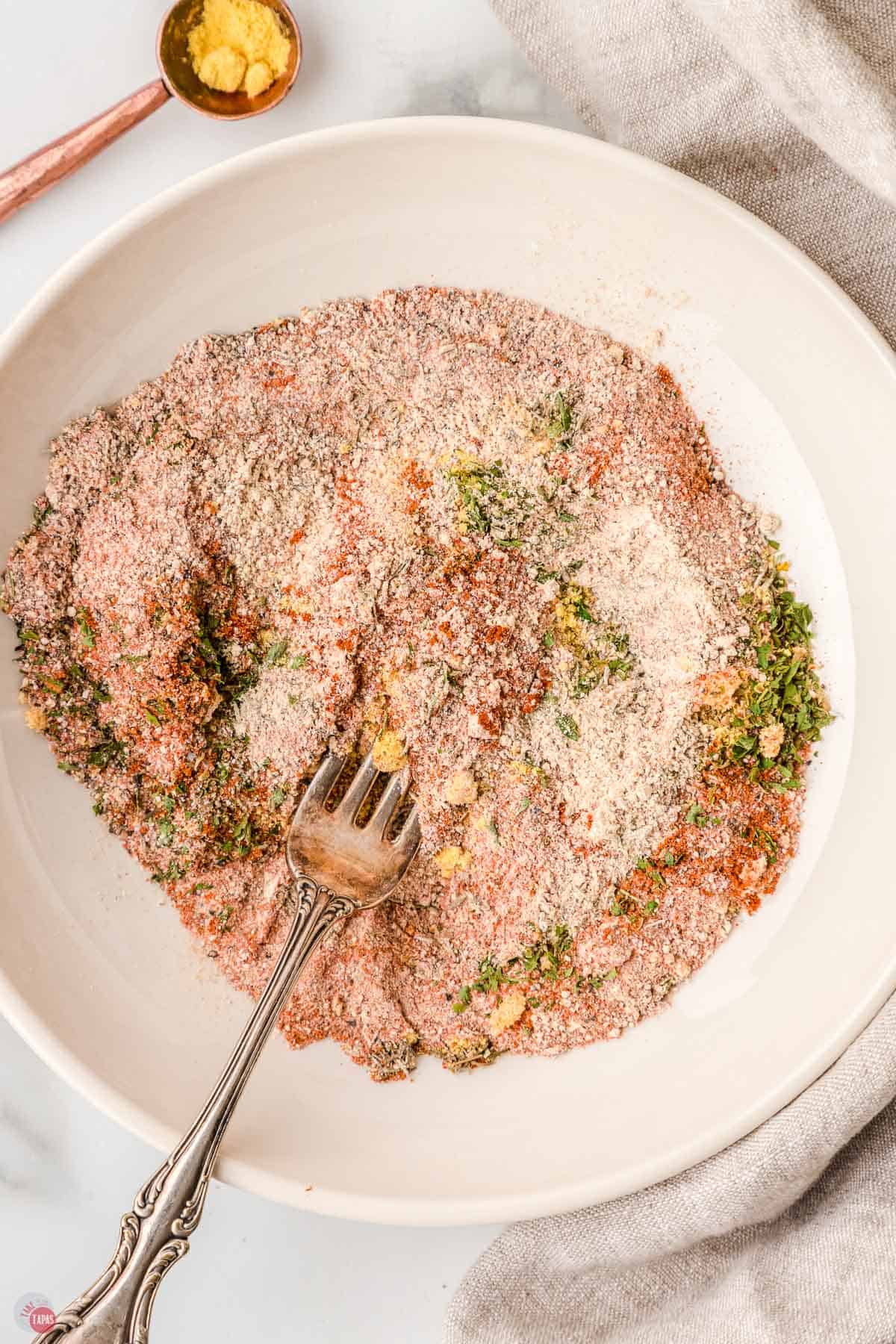
- Combine all the spices in a bowl and whisk to combine.
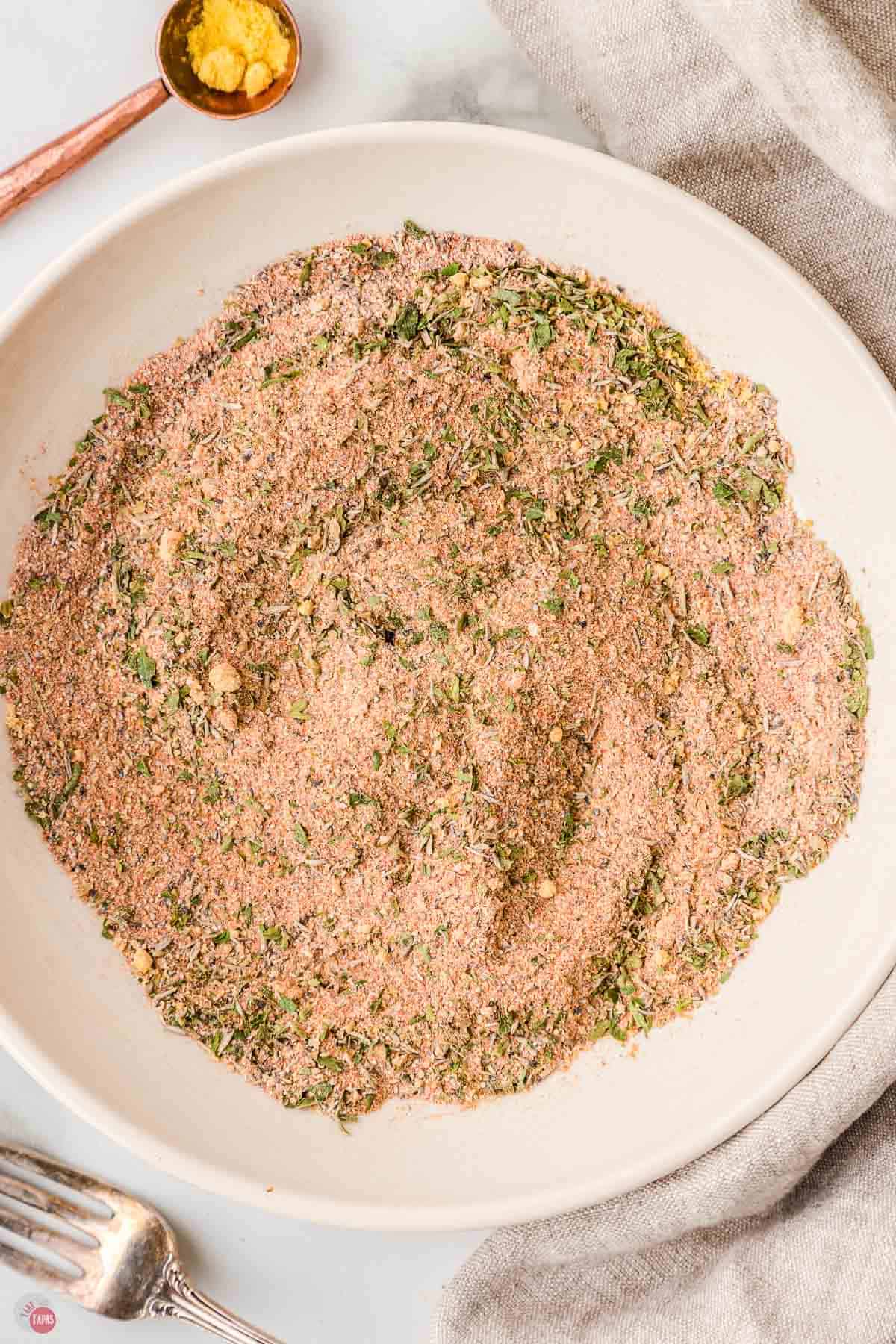
- Store in an airtight container and keep in a cool, dry place.
For the full recipe and detailed instructions, please refer to the recipe card at the bottom of the post.
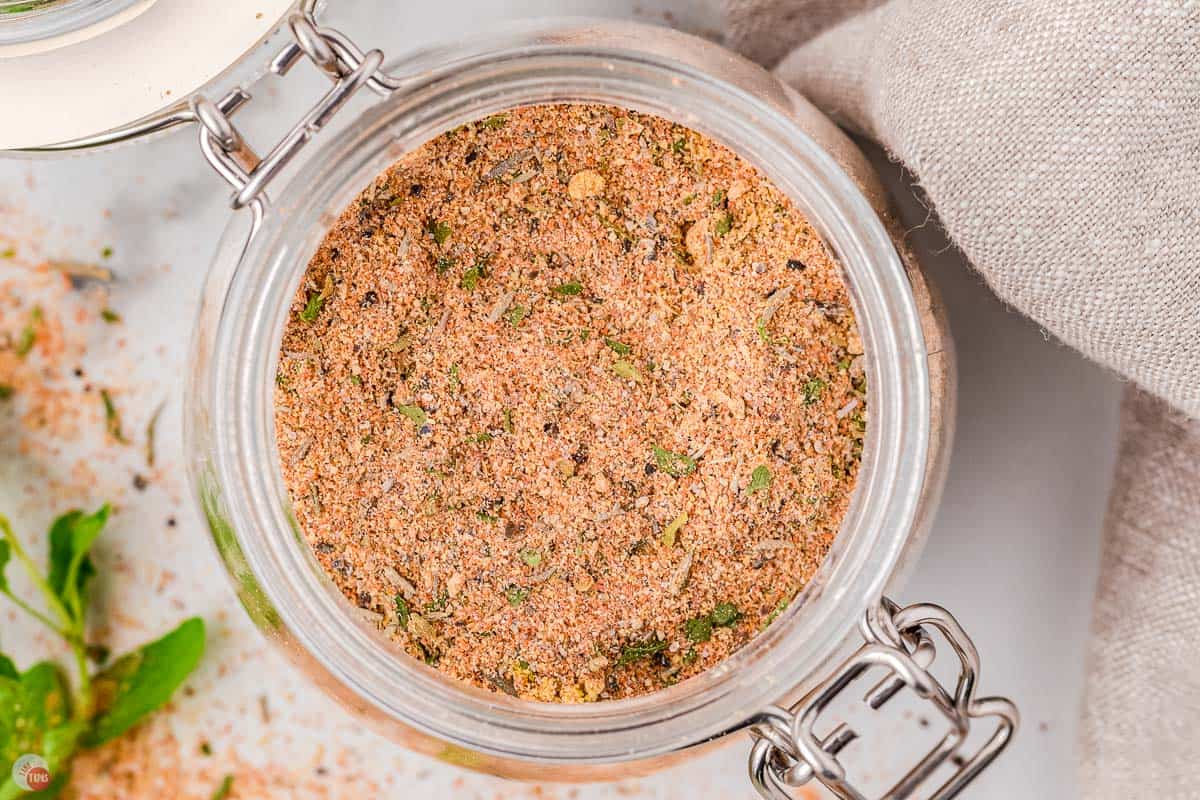
After you mix all the ingredients together in a small bowl, store it in a cool, dry place. It will last up to 3 months.
I like to keep all my spice blends in glass jars as they are reusable, airtight, and don’t hold the flavors of the previous mixes.
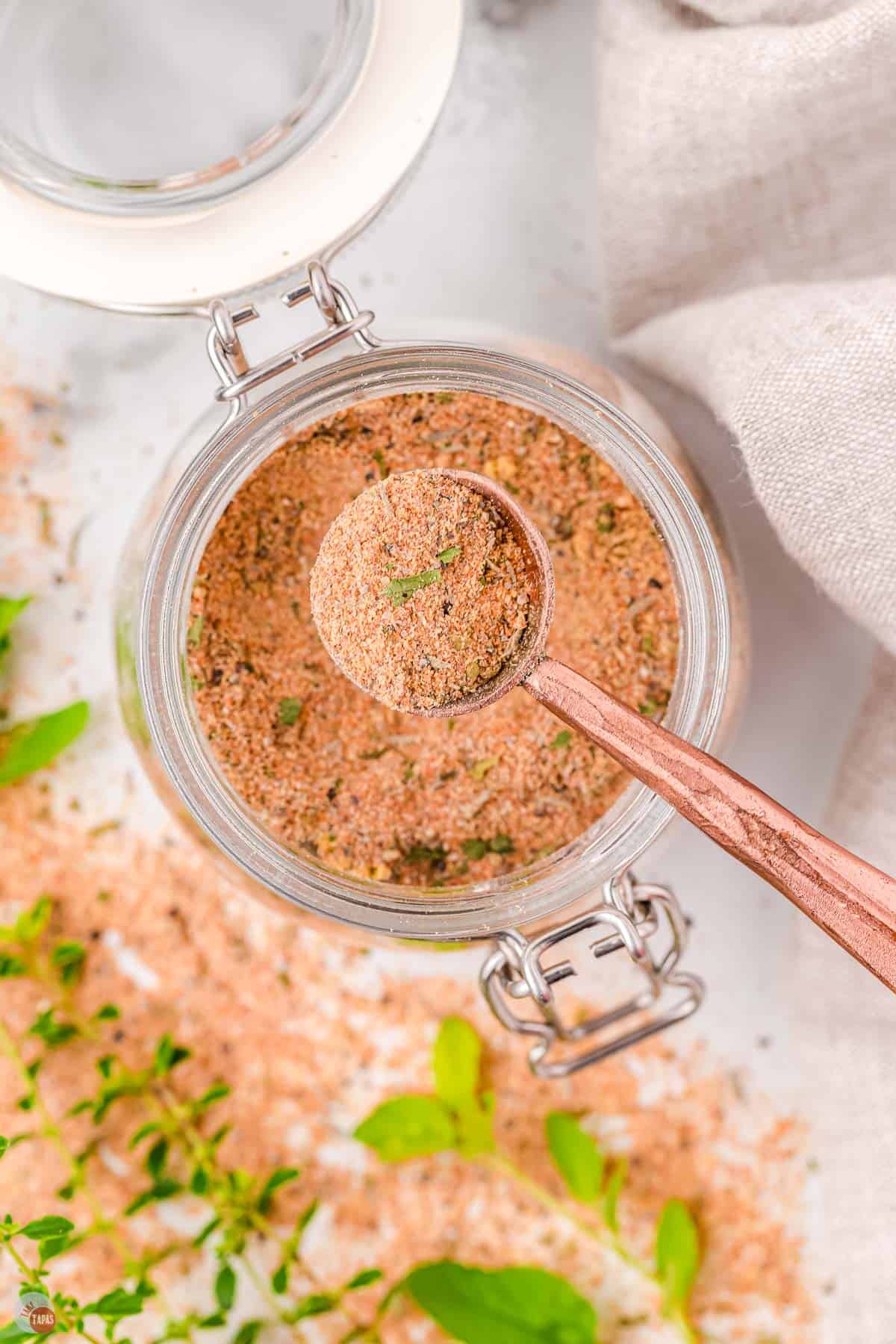
Herbs: basil, parsley, thyme, rosemary, oregano.Spices: garlic powder, onion powder, salt.Heat: paprika, cayenne pepper, black pepper.
General rule for me is 1 tablespoon per pound of chicken but I like to just make sure that when I sprinkle on the seasoning, I don’t have too many open or empty spots on the meat. For a whole chicken, roughly 3-4 pounds, I like to use 1/4 cup. However you like to season yours, just be sure to start small. You can always add more but you can’t take it off once it’s on there. Don’t forget that salt and pepper go a long way too!
It’s best to put dry seasonings on before you cook it. I like to add mine about 30 minutes before I grill the chicken so it has a chance to stick to the meat and won’t fall off right away. You can also sprinkle a little additional seasoning when it comes off the grill. It’s your meat, so season it how you see fit.
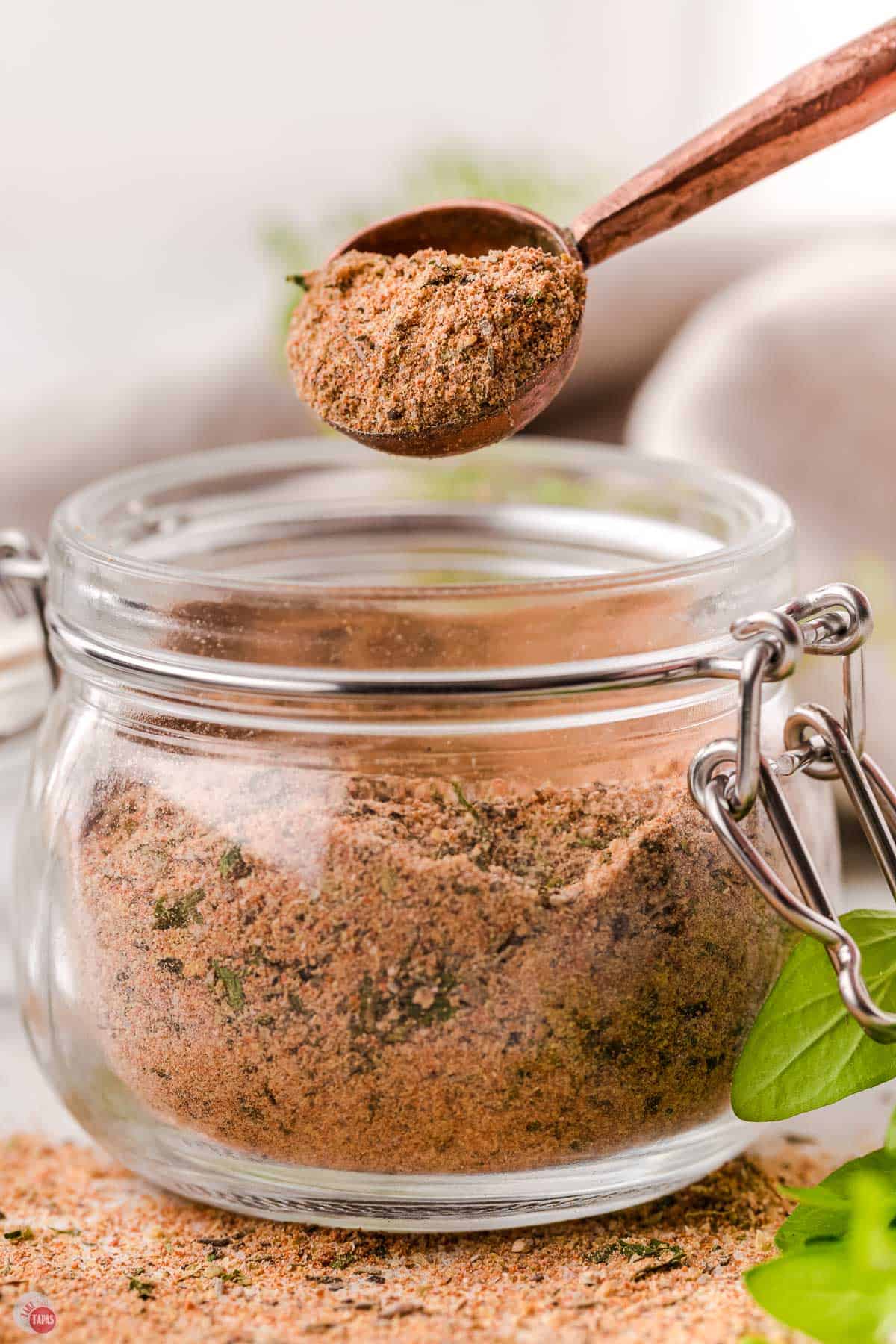
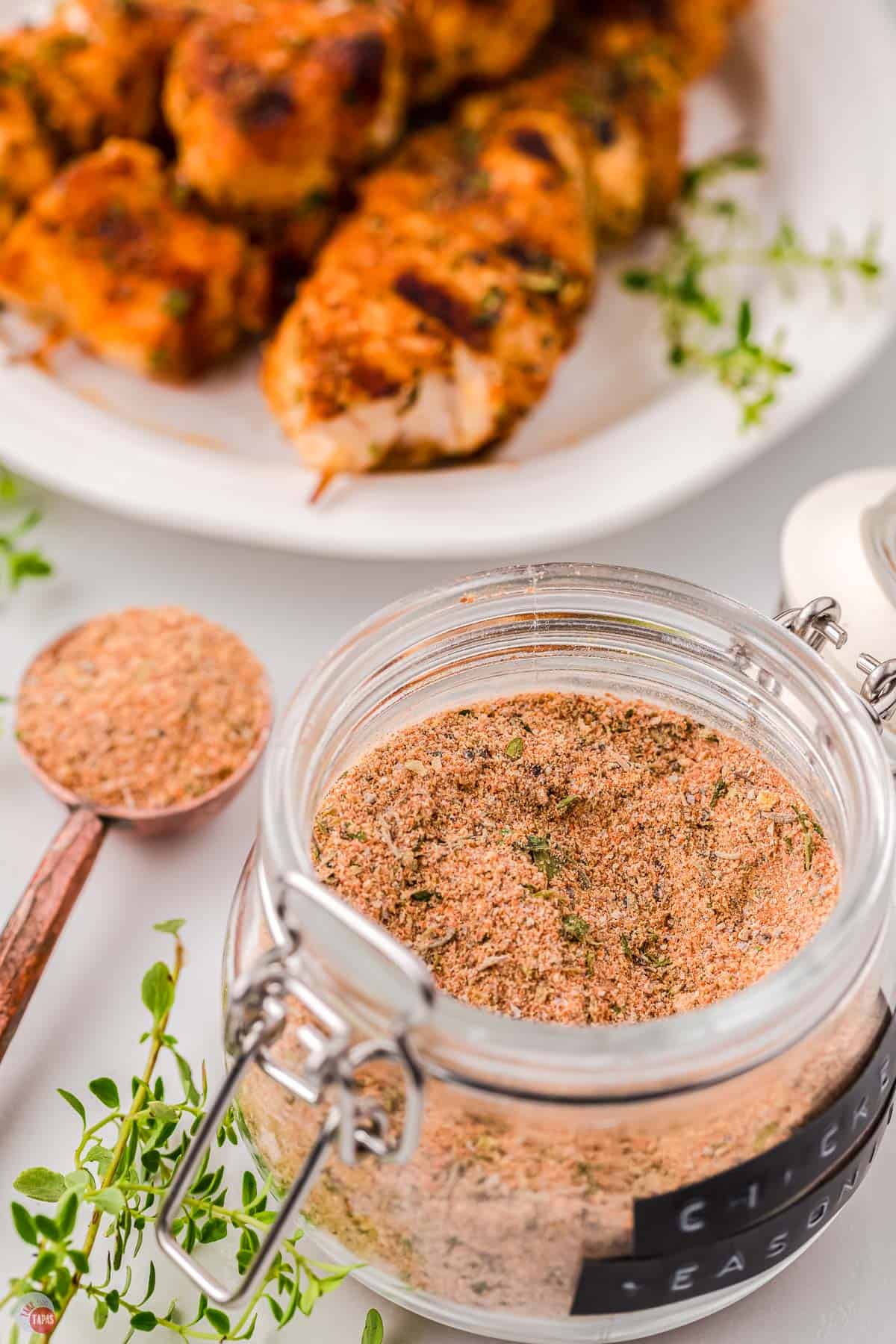
Best Chicken Seasoning Recipe
FAQ
What is a substitute for chicken seasoning powder?
Poultry Seasoning Substitute Both dried sage and dried thyme make the best substitutes for poultry seasoning when you don’t have the four main spices needed to make a homemade mix: sage, thyme, marjoram or oregano, and rosemary.
Is chicken seasoning the same as poultry seasoning?
Poultry seasoning, also known as chicken seasoning, is a blend of herbs and spices that is commonly used to flavor poultry dishes, including chicken and turkey. It is often used as a rub or seasoning mix for roasting, grilling, baking, or pan-frying poultry, adding depth and fragrance to the meat.
What are the most common seasonings for chicken?
It depends on what dish you’re making, but a few classic spices to use with chicken are garlic powder, paprika and good old fashioned salt & pepper. Read on to learn about how to use this spices perfectly in your recipes!
What seasoning do you put in chicken food?
Seasoning: A simple mix of paprika, garlic powder, thyme, salt, and pepper does wonders for plain chicken. You could also use other dried herbs such as oregano or parsley!
